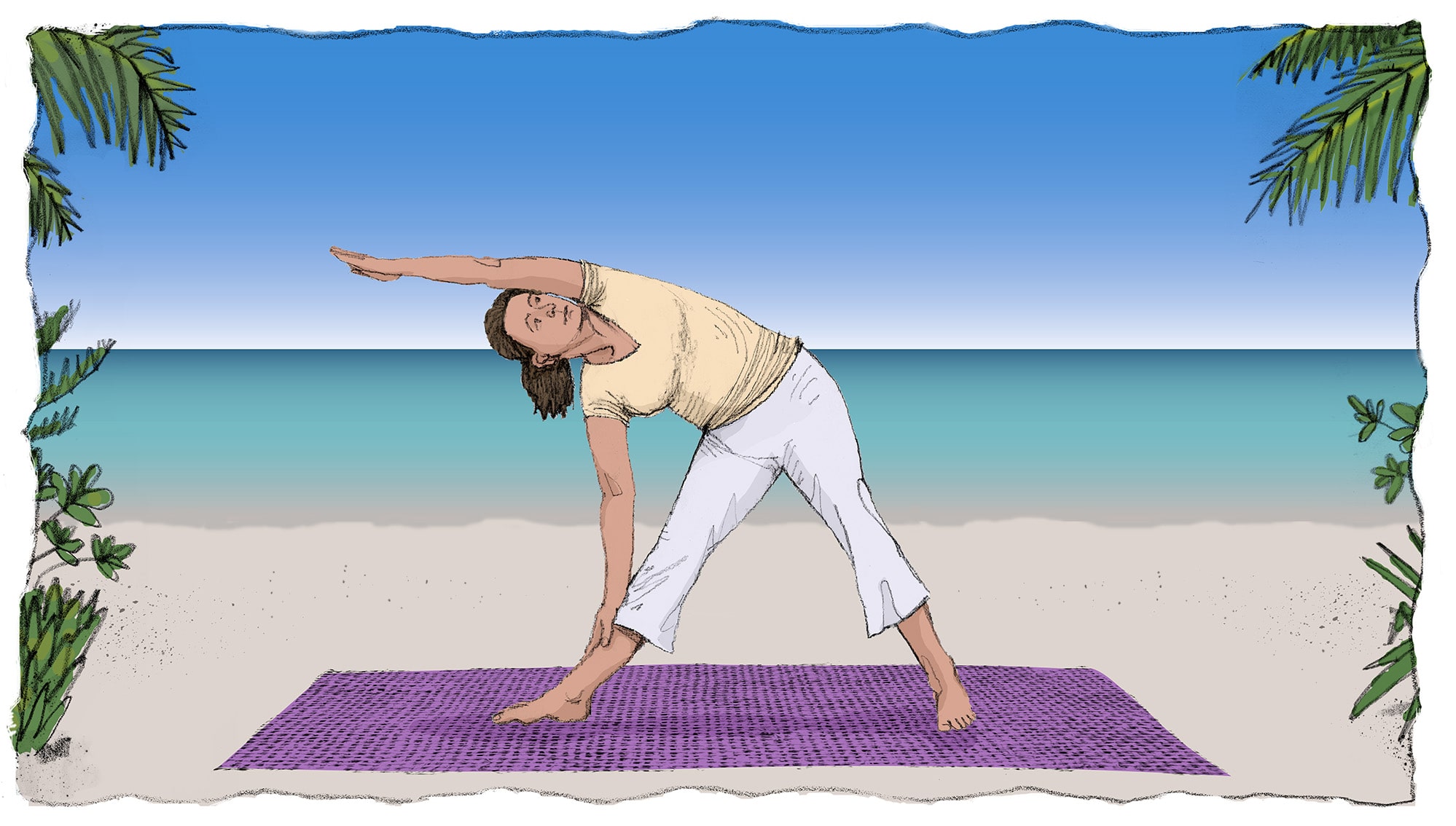Sivananda Bahamas Blog
Expand Your Horizons …
Our Blog
The Wrong Triangle Pose: Sivananda Yoga Posture Stories
By Mark Hanuman Geraghty
Over time, our experience of yoga asanas evolves beyond the physical — the postures become our teachers and companions, showing us our relationship with ourselves and the world. Enjoy this collection of stories submitted by Sivananda Yoga practitioners from around the world, sharing their in-depth connections with each asana of the Sivananda sequence.
Once upon a sunny ashram day, long before I started teaching multiple yoga classes a day, I was a newly minted Sivananda teacher begging to be put on the ashram teaching schedule. Even with my earnestness trumping my experience, my desire was fulfilled (temporarily, as any good Vedantin would know) and I was soon a regular on the ashram platform circuit.
Even before I developed a strong, independent sadhana, I knew deep down that teaching yoga was for me. This was further reinforced, deleteriously so, by certain positive comments and encouragements I received after my classes. I would be standing in the breakfast line waiting for my turn at the bread basket, and someone from class would come up to me and thank me for such a wonderful class. I would muster up a look of surprise — and with faux humility in my hushed words and blushing cheeks, I ate it right up with Gopi’s bread.
One day while perfecting my noiseless steps up and down the creaky Bay Platform, a true lesson in humility was patiently biding its time. We were nearing the end of a wonderful class (as you can see humility is not my forte) and I started my cues for the triangle pose.
Sivananda was my introduction into yogic lifestyle, but not yoga asana. I was relatively well-versed in basic vinyasa flow and its love of variations and transitions. And because of my deep respect for yoga in general and the Sivananda lineage in particular, I understood how important both practices could be in their appropriate time and place. My Sivananda classes adhere to tradition, but I am known to throw in a variation or two, hoping to induce a greater sense of presence and awareness in my students — and to have a little fun.
As I’m guiding the students into the traditional Sivananda triangle pose, I notice a woman, with power yoga energy, going into a different triangle; you know the one with the front leg pointed forward, big toe grasp, hips slightly askew. I nonchalantly came close and said gently:
“This pose is with the feet parallel and the hips aligned.”
She didn’t move an inch, nor look at me for that matter. She just retorted:
“No it’s not.”
I was taken aback. I checked myself, took a breath, and smiled.
“There are many triangle variations, but right now we are doing the one with the feet parallel.”
In a brusque manner, she lifted up out of the pose, glared at me stridently (I’m not sure if it was contempt or condescension, but either way it was unpleasant). Then with a voice pitched to be heard by an audience larger than one, she said:
“Well you clearly have no idea what you are doing and are inexperienced. This is a triangle pose.”
Enough said. With my face straining to maintain some semblance of calm, I walked away as to not betray my true feelings of volcanic rage and humiliation. I actively averted the dozen or so set of eyes following this contretemps.
“Come up out of the pose. Bring your feet together in mountain pose at the top of your mat and close your eyes.”
Did I forget to cue the other side? Probably, but this was not my concern. All I wanted was to get everybody into savasana so it would all be over.
The class ended with no fireworks or terse exchanges with the student. I never saw her again, and none of the other students brought up the incident although there was no doubt they all bore witness to my public crucible. For a few days I wallowed in self-doubt, coming up for air momentarily to wish bad karma on that student, making me feel worse. I just didn’t know what to make of the situation, her reaction, my ego, the public shame, all of it. There seemed to be some deep-rooted lesson beyond my novice’s grasp.
Was I wrong? Was I right? Did it hurt because she said it or because other people heard her say it? Would I be able to teach again without flashbacks forever tempering my teaching style?
“Stop feeding your ego. Get over it. Teach what you’ve learned, and that’s it. Besides, you’re worrying if you’re a good teacher or not. Teach 4-5 classes a day, 5 days a week, for a couple years, and then start asking yourself if you’re a good teacher.”
Words of wisdom from my own teacher. Shaking me out of my stupor, she opened my eyes to a larger truth. Right or wrong, this way or that way, good or bad, it’s not about me. It’s not about the pose or the class or even the student. It’s about yoga. It’s about service. It’s about non-attachment. It’s about doing your best, with the best intention, and letting everything else go.
Lord Krishna sums it up in the Bhagavad Gita: “Abandon all attachments to success and failure. Such equanimity is called yoga.”
****
Every week from January 1 – March 26, 2018, we will be sharing a new story — You can access all of the current ones here.









One thought on “The Wrong Triangle Pose: Sivananda Yoga Posture Stories”
Stewart
Thank you. This was exactly what every teacher needs to internalize